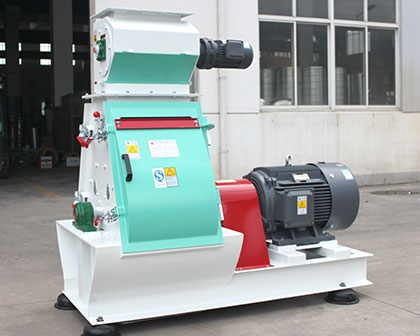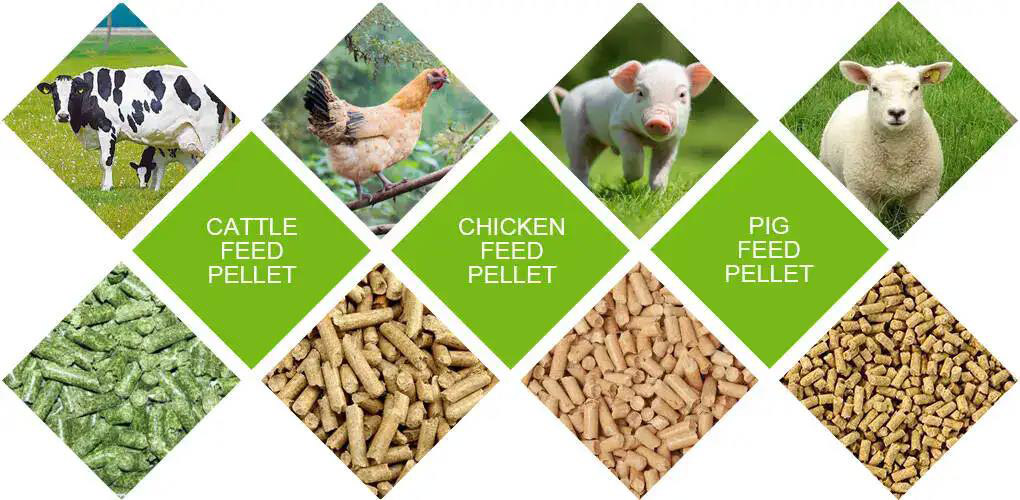The pig feed pellet machine is a feed processing machine. It is mainly used to directly compress the crushed materials such as corn, soybean meal, straw, grass, rice husk and other raw materials into granules.
The pig feed pellet machine is versatile for various scales of aquaculture, feed processing, and farms, improving feed efficiency, reducing waste, and simplifying storage and transport.
1.It has a simple structure, wide adaptability, small footprint, and low noise level.
2.Powdered feeds and grasses pelletize with little to no liquid, preserving raw material moisture for easier storage.
3.Pellet feed benefits chickens, ducks, and fish more economically than powdered feed.
4.Dry processing creates hard, smooth pellets that enhance nutrient absorption and digestion.
5.Pellet formation denatures protease inhibitors in grains and legumes, improving digestion and killing parasites and pathogens, thus reducing disease incidence.

The composition of a pig feed pellet machine typically includes the following main components:
This is the entry point of the pellet machine, responsible for feeding the raw materials into the machine. The feeding chute is usually a stainless steel cone or frustum, ensuring the smooth entry of feed.
Pellet machines use electric motors or diesel engines for power to drive the pelletization process.
Transmission devices like belts and gears deliver power to the main shaft and press wheels for coordinated machine operation.
This is the core part of the pellet machine, including the press wheels and die. The compression and friction between the press wheels and the die shape the raw materials into pellets.
The die determines the shape and size of the pellets. Ring die pellet mills, flat die pellet mills, and twin-roller pellet mills each have their own die systems, suitable for different types of feed production.
In some pellet machines, there may be a cutting system to trim the pellets to the appropriate length if they become too long.
The formed pellets are discharged from the machine through the discharge system, usually via an outlet pipe or funnel.
Modern pellet machines feature electronic controls for monitoring and fine-tuning operational parameters, thereby ensuring production stability and efficiency.
Transitioning to temperature management, some pellet machines include a cooling system to maintain pellet quality by preventing overheating.
Ensuring longevity, the pellet mill typically integrates a lubrication system for routine greasing of vital parts.
These components collaborate to convert raw materials into pellet feed appropriate for pigs, thereby enhancing the feed’s nutritional value and digestibility, and also simplifying storage and transportation.
The pig feed pellet machine primarily reflects its functionalities in the following aspects:
It shapes powdery or fibrous feed materials into pellet form, improving the physical state of the feed for easier consumption by animals.
Pelletized feed is less likely to be wasted compared to powdered feed, reducing loss through scattering and dusting, thereby increasing the overall utilization rate of feed.
The pelleting process ensures thorough mixing of feed ingredients, guaranteeing even distribution of nutrients, and through heat treatment, promotes gelatinization of starches, enhancing the digestibility and absorption rate of the feed.
Pellet feed is compact and dense, less prone to moisture absorption, facilitating long-term storage and long-distance transportation with reduced loss during storage.
The high temperatures involved in the pelleting process can kill harmful microorganisms and parasite eggs in the feed, lowering the incidence of animal diseases.
Pig feed pellet machines can process a variety of raw materials, including corn, soybean meal, straw, grass powder, rice husks, etc., making them suitable for farms and feed mills of different scales.
By reducing feed waste and improving the digestibility and utilization of feed, the long-term use of pellet machines can save significant costs for breeders or feed factories.
Pellet feed produces less dust, reducing environmental pollution, and also decreases losses during storage and transportation, supporting sustainable development.
Users can adjust the parameters of the pellet machine according to the different growth stages and nutritional needs of pigs, producing feed pellets that meet specific requirements.
These functionalities make pig feed pellet machines indispensable equipment in modern animal husbandry and the feed industry, not only improving the efficiency and safety of feed but also supporting the sustainable development of the livestock industry.
| Model | Capacity(T/H) | Main Motor Power(kw) | Feeder Motor Power(kw) | Conditioner Power(kw) | Dia.of Ring Die(mm) | Final Pellet(mm) |
| SZLH250 | 1-2 | 22 | 0.75 | 1.5 | 250 | 2-12 |
| SZLH320 | 3-4 | 37 | 1.5 | 2.2 | 320 | 2-12 |
| SZLH350 | 5-7 | 55 | 1.5 | 3 | 350 | 2-12 |
| SZLH420 | 8-12 | 110 | 1.5 | 7.5 | 420 | 2-12 |
| SZLH508 | 10-18 | 160 | 2.2 | 11 | 508 | 2-12 |
| SZLH558 | 15-25 | 180/200 | 2.2 | 11 | 558 | 2-12 |
| SZLH558D | 14-22 | 160/180/200 | 2.2 | 7.5 | 558 | 2-12 |
| SZLH678 | 20-30 | 220/250 | 2.2 | 11 | 678 | 2-12 |
| SZLH678D | 15-25 | 200/220/250 | 2.2 | 11 | 678 | 2-12 |
| SZLH768 | 25-40 | 280/315 | 2.2 | 11 | 768 | 2-12 |
| SZLH858 | 25-42 | 280/315 | 2.2 | 15 | 858 | 2-12 |
Typically, the production of pig feed pellet machine uses raw materials such as corn, soybeans, wheat, and other nutrients as the formula. Our feed pellet machine are specially used to produce feed for poultry, livestock, pigs, horses, cattle, sheep, chickens, ducks, goose and other animals.For different animals, with different growth cycles, (chicks, suckling pigs, calves, etc.), the feed pellet size required is different, but our feed production line only needs to replace ring molds with different apertures or use a pellet crumbler to reach the required size.
